#Symbolic Language
Explore tagged Tumblr posts
Text
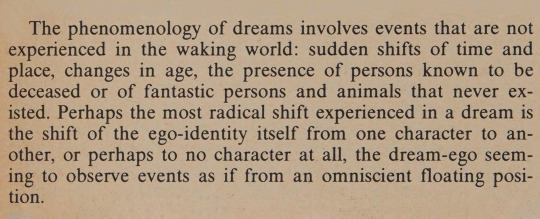
Jungian Dream Interpretation: A Handbook of Theory and Practice by James A. Hall First published: January 1, 1983
#carl jung#james a. hall#carl gustav jung#individuation#jungian epistemology#oneiroi#dreams#myths of the soul#archetypes#depth psychology#collective consciousness#shadow work#symbolic language#words#quotes#academia#dark academia#quote#lit#books#books and libraries#literature#jung#reading#quote of the day#bookworm#january 1
172 notes
·
View notes
Text
"The Initiates of the Flame: Illuminating the Path to Esoteric Wisdom"
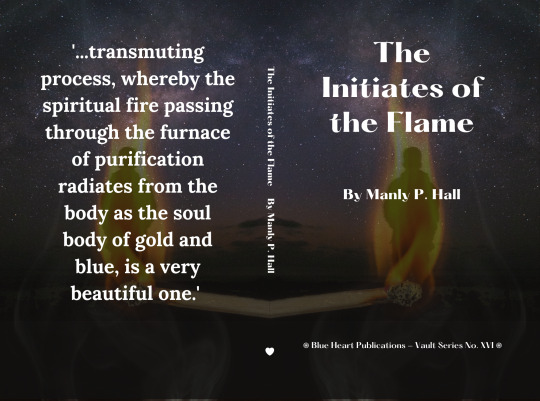
In "The Initiates of the Flame," Manly P. Hall takes readers on a captivating journey into the profound realms of esoteric knowledge and spiritual enlightenment. Hall's meticulous exploration of ancient mystical teachings serves as a beacon, guiding readers through the intricate tapestry of secret wisdom. With eloquence and depth, the author unravels the symbolic language of the initiates, revealing timeless truths that resonate with seekers of spiritual understanding.
Hall's narrative is a tapestry woven with threads of mystery, unveiling the sacred rites, hidden symbols, and spiritual allegories passed down through the ages. The book becomes a key unlocking the doors to higher consciousness, inviting readers to contemplate the esoteric principles that underpin the universe. As Hall delves into the teachings of the initiates, he sheds light on the transformative journey one must undertake to unlock the secrets of the flame—the eternal source of spiritual illumination.
The Initiates of the Flame is not merely a book; it is a profound meditation on the esoteric traditions that have shaped humanity's quest for spiritual enlightenment. Hall's insights are a testament to his deep understanding of the ancient mysteries, offering readers a glimpse into the hidden dimensions of existence. This work is a must-read for those who seek to unravel the mysteries of the flame and embark on a transformative journey toward higher knowledge and self-realization.
"The Initiates of the Flame," Manly P. Hall is available in Amazon in paperback 10.99$ and hardcover 18.99$ editions.
Number of pages: 167
Language: English
Rating: 9/10
Link of the book!
Review By: King's Cat
#Esoteric Wisdom#Spiritual Illumination#Ancient Mysteries#Initiatic Teachings#Hidden Symbols#Symbolic Language#Higher Consciousness#Spiritual Transformation#Sacred Rites#Mystical Traditions#Secret Knowledge#Spiritual Allegories#Metaphysical Exploration#Initiatory Journey#Universal Truths#Occult Wisdom#Hermetic Philosophy#Alchemical Insights#Transcendental Knowledge#Self-Realization
6 notes
·
View notes
Text
"Reflecting the Alchemist's Soul: Unveiling the Mysteries in 'The Mirror of Alchimy' by Roger Bacon"
In "The Mirror of Alchimy" Roger Bacon takes readers on a mesmerizing journey into the enigmatic world of alchemy, unraveling the veiled mysteries that have captivated seekers of esoteric knowledge for centuries. This seminal work, written in the late 16th century, serves as a timeless portal into the alchemical tradition, offering profound insights into the transformative processes of both the philosopher's stone and the adept's soul.
Bacon's narrative is a tapestry woven with allegorical threads, blending practical laboratory instructions with symbolic language that transcends the material realm. As the alchemist-author, Bacon speaks to readers across time, inviting them to contemplate the union of opposites, the refinement of base elements, and the pursuit of the elusive Elixir of Life.
The Mirror of Alchimy serves as a guide for those daring enough to tread the intricate labyrinth of spiritual transmutation. Bacon's prose, though rooted in the medieval context, resonates with universal themes— the quest for enlightenment, the cyclic nature of creation and destruction, and the pursuit of the divine within the earthly vessel.
At its core, this alchemical mirror reflects not only the external processes of laboratory experimentation but also the internal journey of self-discovery. Bacon intricately intertwines the art of transmutation with the science of the soul, urging the seeker to alchemize their own consciousness in tandem with their laboratory pursuits.
The brilliance of Bacon's work lies not only in its practicality but also in its poetic invocation of the alchemical quest. Each chapter unfolds like a mystical incantation, beckoning the reader to delve deeper into the alchemical opus. From the stages of calcination to coagulation, Bacon demystifies the alchemical process, making it accessible to both seasoned practitioners and those new to the alchemical tradition.
"The Mirror of Alchimy" is an illuminating testament to the enduring allure of alchemy—a profound exploration of the interconnectedness between the earthly and the celestial. As readers gaze into this alchemical mirror, they are not only confronted with the reflection of laboratory apparatus but also with the hidden recesses of their own spiritual landscape.
In a world where the pursuit of wisdom is often obscured by the mundane, Bacon's mirror serves as a timeless reminder that, like the alchemists of old, we are all engaged in the grand work of refining ourselves, transmuting the leaden aspects of our existence into the gold of inner enlightenment.
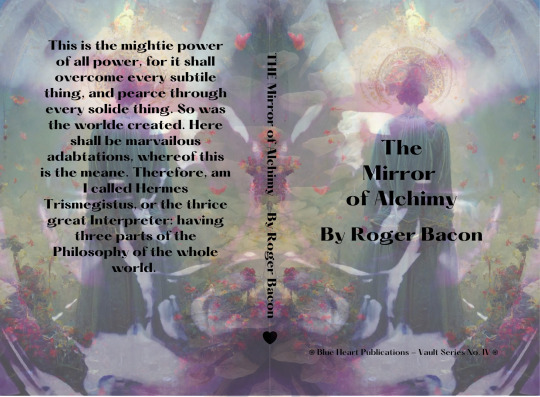
Roger Bacon's "The Mirror of Alchimy" is available in Amazon in paperback 12.99$ and hardcover 20.99$ editions.
Number of pages: 163
Language: English
Rating: 8/10 (Old English and Challenging Reading just like many alchemical works!!!)
Link of the book! (Hardcover); (Paperback)
Review By: King's Cat
#Alchemy#Roger Bacon#Hermeticism#Esoteric Knowledge#Medieval Philosophy#Alchemical Processes#Spiritual Transformation#Ancient Wisdom#Alchemical Symbols#Transmutation#Philosopher's Stone#Occult Science#Symbolism in Alchemy#Mystical Texts#Medieval Alchemist#Manuscripts#Alchemical Tradition#Spiritual Enlightenment#Hidden Knowledge#Symbolic Language
4 notes
·
View notes
Text
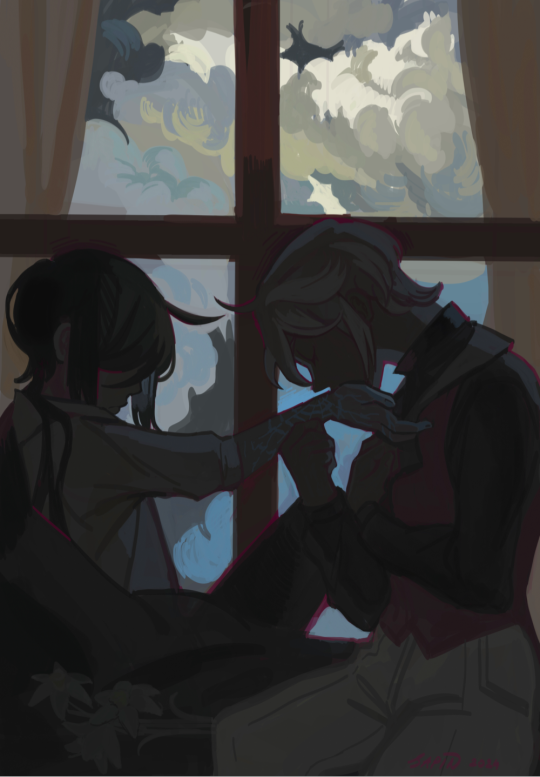
daffodils
#do you see those clouds yup im proud of them#you see this widow frame? but is it really that 🤨...#a lot of symbolism#recommend reading abt daffodils meaning<3#fanart#art#digital art#vanoe#daffodil#flower language#vanitas#vnc#vanitas no carte#noe archiviste
4K notes
·
View notes
Quote
In philosophy, one is constantly tempted to invent a mythology of symbolism or of psychology, instead of simply saying what we know.
Ludwig Wittgenstein, Philosophical Grammar
#philosophy#quotes#Ludwig Wittgenstein#Philosophical Grammar#mythology#symbols#psychology#clarity#grammar#language
539 notes
·
View notes
Text

last words of a shooting star
#mouthwashing#anya mouthwashing#apparently i am not immune to the dental hygiene game. had to draw my beautiful wife#the flowers are carnations which symbolize motherhood in flower language#mouthwashing fanart#horror art#wrong organ#cw gore#cw medical#artists on tumblr#cw pregnancy
550 notes
·
View notes
Text
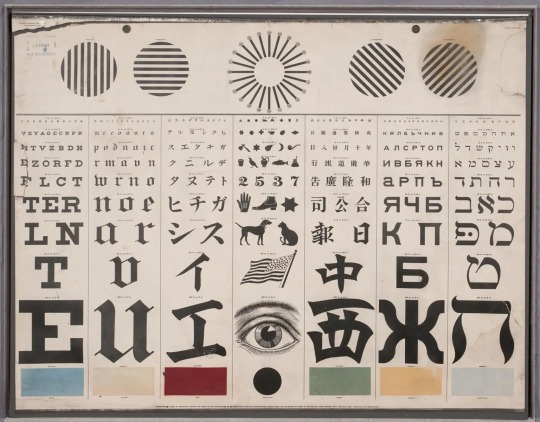
George Mayerle's "international eye chart"
(positive) ca. 1907.
One of many immigrants to live in early 20th-century San Francisco, Mayerle — an optician originally from Germany — invented this chart which allowed anyone to do an eye test regardless of what language they spoke.
#invention#chart#graph#eye#optician#optics#graphic#design#typography#language#symbol#sight#vision#opthalmology#medicine#beige#multi
452 notes
·
View notes
Text
"I like food"
I saw many posts people saying how random Shouto's line is about praying at Touya's altar and realizing that he likes food - and I wanted to point to how it helps wrapping up his arc.


Shouto is saying: "When I was praying at Touya's butsudan (Buddhist altar), I suddenly realized something, I liked eating food. I realized there's more to me than just the person I want to become."
Food was a "negative space in the Todoroki family, so liking food was not evident to Shoto growing up.
In Shouto's flashbacks with his family, we never see him eat food. His only memory tied to the kitchen is the kettle incident. We know from Natsuo that Shouto ate alone, a diet prescribed by Endeavor, no doubt all geared towards maximum performance, rather than enjoyment. Not even knowing your siblings favorite food is the ultimate symbol of how dysfunctional the household was.

2. Food was a positive space in Class A - tied to comfort, bonding, friendship
In class A, Shouto starts eating with Iida and Midoriya after the Stain incident. Food becomes comfort, connection, sharing, caring, teamwork, etc. He experiences things like using his fire to prepare food together, eating together, cleaning up.
Many memorable Shouto-scenes are tied to Class A eating together (e.g. heroes cry too) and he connects to Inasa over a discussion about favorite foods (udon vs soba) which is a theme that carries over to his endgame with Touya

3. As the Todoroki family tries to reconnect, food plays a central role
As the family changes, they attempt to reconnect around the family dinner table (the famous sluuurp scenes). But Todoroki dinners end in a disaster - still they are useful bringing to the surface important conflicts and trying to communicate about them (another important theme discussed in Shoto Rising).
There is more in the light novels: Shoto's and Rei's decade late reconnection as Rei offers him a little kid strawberry milk that she remembers he liked when he was 5, and their attempt to connect with Natsuo ending up in a mush of ruined soba - it's all out of sync.

4. Food as a symbol of lost time and broken futures
Food is also very central for the hopes of a happier future: Enji's dream of his family at the dinner table, Natsuo's regret about years of missed meals, Shoto wanting to share noodles with Toya, all culminating in the heartbreaking realization that they have the same favorite food they'll never get to share.

5. Food as a symbol of processing grief and healing
Praying at the butsudan (the Buddhist altar at home set up for a deceased loved one) involves the preparation of offerings of food and drinks, which then the family eats afterwards. We see this practice referenced in Ch 249 when Enji prays at Toya's altar.

So Shouto making a reference to it is a shorthand for telling us that Touya died at some point, Shouto is still grieving him and just like Deku and Ochako, he's trying to make sense for himself out of their short encounter. So wanting to learn how to make chopsticks and bowls (a traditional Japanese craft of woodwork and applying lacquer, often involving intricate patterns) implies that he wants to bring Touya the perfect offering, but also that he's finally stepping outside fully of the framework Endeavor created for the family, where children are cast into roles of heroes, villains and by-standers, masterpieces and failures but never human beings. He's thinking about what connects him and Touya together and who they would have been in a different story.
6. Shouto's personal arc
Shouto's character was always about balance. Balance between past and future, ice and fire, duty and family, etc. So crafting chopsticks and bowls to elevate good food connects the grief and survival guilt with healing and growth. It is both a tribute to Touya's memory and a new possible hobby to express still undiscovered sides of himself.
It fits the theme of the chapter "More" - as it focuses on what lies beyond being a hero, reaching a goal, working hard and how Izuku, Ochako and Shouto have been transformed by their experiences of trying to save their villains.
But it also fits Shouto's personal arc that was about discovering who Shouto really is. Earlier in the chapter, Shouto refers to being constrained into the framework of a bigger story, where his choices are bound to happen. As a hero of the sidestory of that manga, Shouto has no choice but decide what kind of a hero he wants to be (not-Endeavor, like All Might, reassuring, family hero). Encounters with his family helped crystallized this image of himself.
But now that he's being released from this story, he can look outside of the framework of a hero manga and discover those "more sides than just a hero". And Touya was the last encounter - the last piece of that puzzle. I think there is a parallel in how Tomura destroyed much of hero society - Touya also destroyed the foundations of the Todoroki family, so something different can maybe built.
Without Touya, I think the family would have kept at trying to piece themselves together in a tense, fake kind of peace to keep up appearances. If nothing else, Touya's actions tore through that need of saving face - leaving them all exposed and grappling with the harsh realities of their actions. But I think it also allowed the younger siblings to step outside the cage their parents created for them and build things better from scratch. It allows them to find more sides to themselves outside of the logic of the Todoroki household.
#bnha meta#bnha 431#todoroki shouto#todoroki touya#dabi#class a#todoroki family#food as a symbol#food as a love language
376 notes
·
View notes
Note
do you remember your father?? i mean, if you remember having one as a pup
"My other parent...?"

"I don't remember them... him... at all. I'm sorry." She says as if apologizing to herself. "Mom would never talk about him, and I was too young to even understand you need a mate to have pups, or that slugcats form colonies."
Marbles is lost in her thoughts again. You keep asking questions, and it unearths some of her long forgotten memories.
"There was this one time... me, my sibling, and mom, we got to observe a big noodlefly nest. I saw their delicious eggs hanging from the ceiling for the first time. When I asked mom about it, she explained that when two noots pair up, they lay their eggs in safe places so they could hatch. Little baby noodles attach to the parent's tail for safety. «Like slugcats!», she said. So, of course my tiny child mind pressed on. «Do slugpups hatch from eggs? Can I lay an egg? Can I eat egg? Was I a good egg?». Mom put up with my nonsense, I think she found it funny... until my brilliant child brain connected the dots, and asked «if I'm an egg, then who did she make me with». She hesitated, and the brief silence mixed with the look on her face is what seared that moment into my mind. «...With your father, of course. But, he's gone. Let's go get something to eat now. You want a blue fruit? I think we can get some of them down the pipe over there...», Mom blurted out as she took my hand in hers. I followed with «Why?», but she pretended not to hear it. In the end, my mind was quickly distracted from asking any more awkward questions by the promise of a tasty meal. I can't remember any other time my second parent was brought up again..."
#rain world#rain world oc#rain world au#rw pioneer#rw slugcat#rw slugpup#rw artificer's pups#au lore#ask blog#this is not a mark of comm btw#just... like... a symbol of a new person/consciousness being brought to life#newborn baby Marbles#she is smol#i gotta say - writing is hard and doing it in your non-native language is even harder
266 notes
·
View notes
Text
my favorite part of the monster high fandom is getting blacklisted by the 'accepting and diverse community' for agreeing ghoulia is not good noverbal rep because it's been confirmed by two different creators that that wasn't the intent for her and because zombese is an ACTUAL LANGUAGE in the monsterverse, meaning that the grunts are not substitutes for words, they are ACTUAL WORDS.
#allegorize it all you want but some of y'all take this headcanon too seriously#ghoulia yelps#monster high#monster high ghoulia#monster high g1#monster high g3#someone said ghoulia is more symbolic of natives/foreigners who aren't understood by the general population due to language barriers#that someone is so right
396 notes
·
View notes
Text
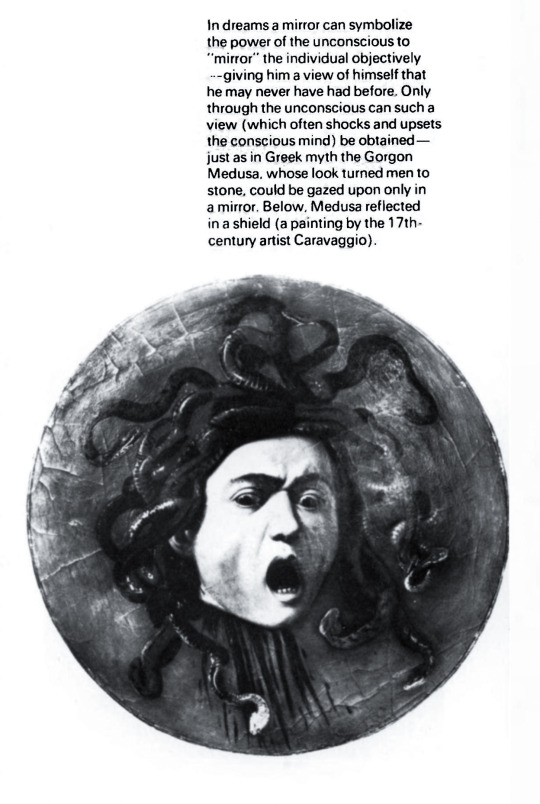
Carl Gustav Jung, Man and his Symbols First published 1964
#man and his symbols#carl jung#carl gustav jung#psyche and myth#shadow integration#self confrontation#individuation#jungian epistemology#dreams#mirror#medusa#archetypes#mythology#depth psychology#collective consciousness#symbolic language#caravaggio#greek mythology#words#quotes#academia#dark academia#quote#lit#books#books and libraries#literature#reading#quote of the day#bookworm
177 notes
·
View notes
Text
Illuminating the Arcane: A Deep Dive into The Hermetic Museum by Arthur Edward Waite

Arthur Edward Waite's "The Hermetic Museum" is a mesmerizing journey into the depths of esoteric knowledge and mystical wisdom. This collection of alchemical and hermetic texts, compiled and translated by Waite, offers readers a rare glimpse into the arcane traditions of Western occultism. Spanning centuries of mystical exploration, the texts included in this volume delve into the secrets of alchemy, astrology, and ceremonial magic, presenting a tapestry of ancient wisdom that continues to captivate seekers of truth and enlightenment.
Waite's meticulous curation of these texts provides readers with a comprehensive overview of the Hermetic tradition, drawing from a wide array of sources including medieval manuscripts, grimoires, and alchemical treatises. From the enigmatic writings of Hermes Trismegistus to the alchemical allegories of Paracelsus, each text offers unique insights into the mystical underpinnings of the universe and the quest for spiritual transformation.
One of the most striking aspects of "The Hermetic Museum" is its ability to transcend time and space, offering readers a timeless glimpse into the perennial wisdom of the Hermetic tradition. Whether exploring the symbolic language of alchemy or delving into the mysteries of the Philosopher's Stone, each text invites readers to embark on a journey of inner alchemy, guiding them towards a deeper understanding of the self and the cosmos.
At its core, "The Hermetic Museum" is a testament to the enduring power of esoteric knowledge and the timeless quest for spiritual enlightenment. Arthur Edward Waite's masterful compilation and translation breathe new life into these ancient texts, ensuring that they remain an invaluable resource for seekers of wisdom and truth for generations to come.
In conclusion, "The Hermetic Museum" stands as a profound testament to the enduring legacy of the Hermetic tradition, offering readers a rich tapestry of mystical wisdom and esoteric knowledge. Whether you are a seasoned practitioner of the occult arts or simply a curious seeker of truth, this volume is sure to inspire and enlighten, inviting you to embark on a transformative journey into the hidden realms of the Hermetic tradition.
Arthur Edward Waite's "The Hermetic Museum" published in two volumes is available Amazon in V1 paperback 24.99$ and hardcover 32.99$, V2 paperback 23.99$ and hardcover 32.99$, editions.
Number of pages: V1 350 pg; V2 302 pg
Language: English
Rating: 10/10
Link of the book! V1
Link of the book! V2
Review By: King's Cat
#Hermetic Museum#Arthur Edward Waite#Esoteric knowledge#Alchemical texts#Mystical wisdom#Western occultism#Alchemy#Astrology#Ceremonial magic#Ancient wisdom#Hermes Trismegistus#Paracelsus#Philosopher's Stone#Spiritual transformation#Medieval manuscripts#Grimoires#Alchemical allegories#Symbolic language#Perennial wisdom#Inner alchemy#Hermetic tradition#Spiritual enlightenment#Quest for truth#Timeless wisdom#Mystical exploration#Arcane knowledge#Esoteric tradition#Spiritual alchemy#Transformational journey#Self-discovery
1 note
·
View note
Text
Illuminating the Arcane: A Deep Dive into The Hermetic Museum by Arthur Edward Waite

Arthur Edward Waite's "The Hermetic Museum" is a mesmerizing journey into the depths of esoteric knowledge and mystical wisdom. This collection of alchemical and hermetic texts, compiled and translated by Waite, offers readers a rare glimpse into the arcane traditions of Western occultism. Spanning centuries of mystical exploration, the texts included in this volume delve into the secrets of alchemy, astrology, and ceremonial magic, presenting a tapestry of ancient wisdom that continues to captivate seekers of truth and enlightenment.
Waite's meticulous curation of these texts provides readers with a comprehensive overview of the Hermetic tradition, drawing from a wide array of sources including medieval manuscripts, grimoires, and alchemical treatises. From the enigmatic writings of Hermes Trismegistus to the alchemical allegories of Paracelsus, each text offers unique insights into the mystical underpinnings of the universe and the quest for spiritual transformation.
One of the most striking aspects of "The Hermetic Museum" is its ability to transcend time and space, offering readers a timeless glimpse into the perennial wisdom of the Hermetic tradition. Whether exploring the symbolic language of alchemy or delving into the mysteries of the Philosopher's Stone, each text invites readers to embark on a journey of inner alchemy, guiding them towards a deeper understanding of the self and the cosmos.
At its core, "The Hermetic Museum" is a testament to the enduring power of esoteric knowledge and the timeless quest for spiritual enlightenment. Arthur Edward Waite's masterful compilation and translation breathe new life into these ancient texts, ensuring that they remain an invaluable resource for seekers of wisdom and truth for generations to come.
In conclusion, "The Hermetic Museum" stands as a profound testament to the enduring legacy of the Hermetic tradition, offering readers a rich tapestry of mystical wisdom and esoteric knowledge. Whether you are a seasoned practitioner of the occult arts or simply a curious seeker of truth, this volume is sure to inspire and enlighten, inviting you to embark on a transformative journey into the hidden realms of the Hermetic tradition.
Arthur Edward Waite's "The Hermetic Museum" published in two volumes is available Amazon in V1 paperback 24.99$ and hardcover 32.99$, V2 paperback 23.99$ and hardcover 32.99$, editions.
Number of pages: V1 350 pg; V2 302 pg
Language: English
Rating: 10/10
Link of the book! V1
Link of the book! V2
Review By: King's Cat
#Hermetic Museum#Arthur Edward Waite#Esoteric knowledge#Alchemical texts#Mystical wisdom#Western occultism#Alchemy#Astrology#Ceremonial magic#Ancient wisdom#Hermes Trismegistus#Paracelsus#Philosopher's Stone#Spiritual transformation#Medieval manuscripts#Grimoires#Alchemical allegories#Symbolic language#Perennial wisdom#Inner alchemy#Hermetic tradition#Spiritual enlightenment#Quest for truth#Timeless wisdom#Mystical exploration#Arcane knowledge#Esoteric tradition#Spiritual alchemy#Transformational journey#Self-discovery
0 notes
Text

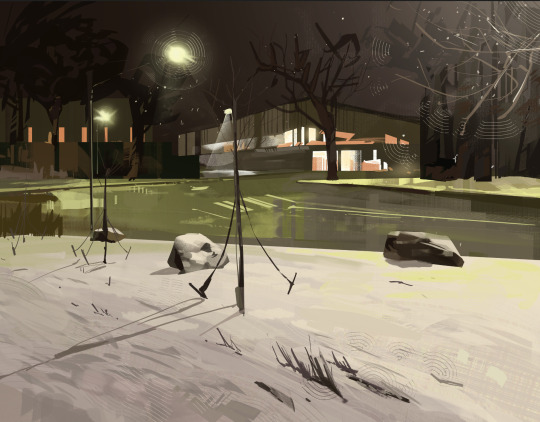
some concept stuff (nova worldbuilding)
#project nova#second is of my uni last week but i think i’m going to use it as a city/astute campus ref….#this is slightly (?) related but i love symbolism. so much…this means almost everything i draw (esp oc stuff) has symbolism in it whether+#it’s body language or looking at the camera etc…i try to make parallels for like guilt and innocence that will hopefully (!!) make sense +#altogether at some point. anyway just thought i’d mention it bc i never have so i do want to like hint that i try to make compositions more#than just fun angles and colors...at least for stuff that isnt just sketches bc its sooo cool frfr#this isn’t really related to that since they’re enviro stuff but you know it’s in the same alley#oc#concept art#environment art#kokoart#environment#drawing#ocs#background art#city
137 notes
·
View notes
Text


Crows and plant symbolism (1/3: Wesper)
616 notes
·
View notes
Text
some pluralkit display names for u!
e name ⁺ prns prns
★ NAME !? . PRNS PRNS
name ₒᵣ name • prns prns
e ◟ name name prns prns ◝
♪ name ! prns prns ~
❯❯ NAME ⁰¹ NAME ⁰² . PRNS PRNS
name 。 prns¹ prns²
e NAME ! PRNS + PRNS
e ⁔ name ₊ name ﹐ prns prns
❛ e ﹐ name prns prns ⊃
any system origin can use this!
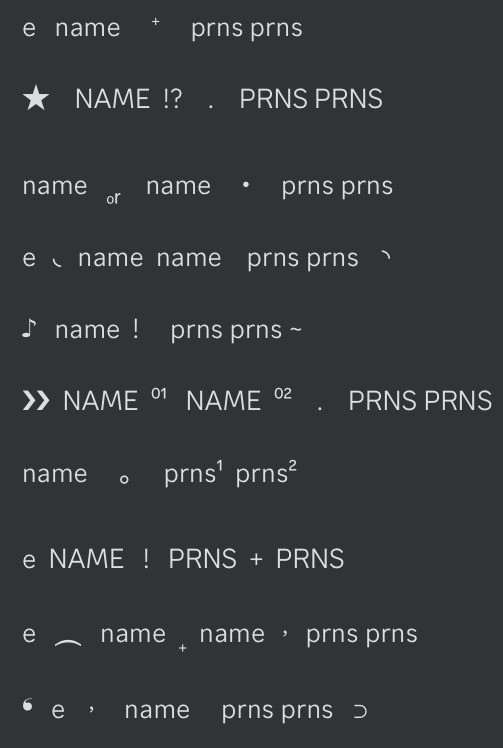
#endogenic#endo safe#pro endo#endo friendly#pluralkit template#pluralkit#display name template#dn template#template#plural system#plurality#plural community#discord template#discord#alter template#non language symbols#no lang symbols#text art
1K notes
·
View notes